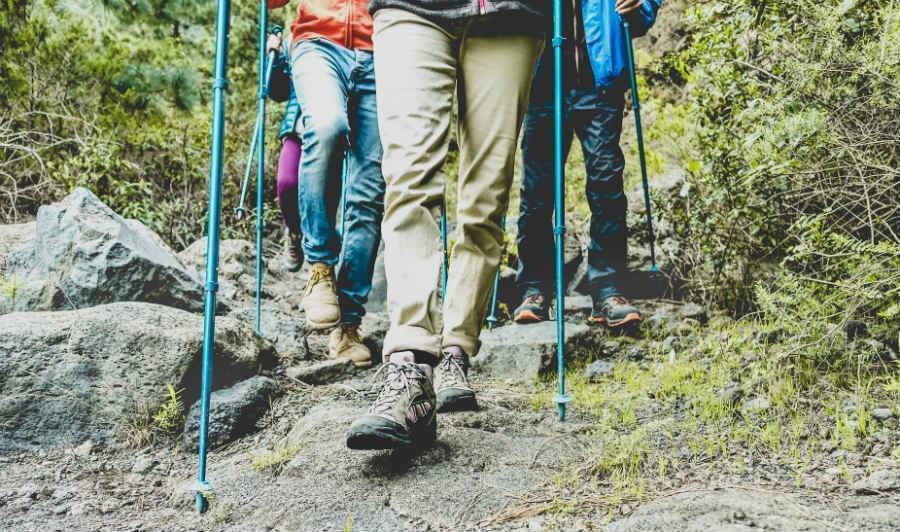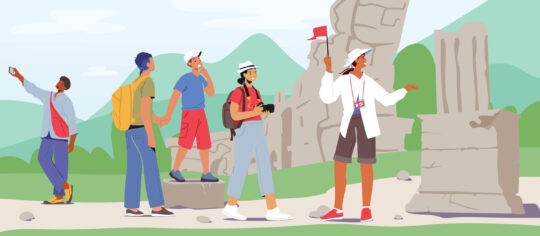Your tours and activities shouldn’t be the only unforgettable thing. Guests should remember your tour name, too. That’s where the importance of branding comes into play.
As a marketing tactic, branding personifies your tourism business. It gives you a voice, looks, personality, and values — which makes you more relatable to your guests and other travelers. Ultimately, a well-defined brand helps you appeal to the right audience, as well as leave a lasting impression.
If you want to create a brand identity or tweak your current one, this article is just for you. We outline what you need to know about positioning and differentiating your business — which includes:
- The importance of a tourism branding strategy
- How to create a memorable travel brand
- 15 travel branding ideas
So let’s get started:
The importance of a tourism branding strategy
Frequently, tour and activity operators lose sight of their brand when they rely heavily on Online Travel Agents (OTAs) for bookings. Although these channels help to expand your reach, they don’t necessarily do your brand justice. That’s because you’re just another listing on their site — meaning you get absorbed into their brand identity instead.
Think of it this way. A traveler who books your tours and activities on Tripadvisor encounters the Tripadvisor brand throughout the booking journey — not yours. Consequently, they don’t get much of a chance to become familiar with your business. When it comes to referrals or repeat bookings, they’ll remember Tripadvisor, but will have a harder time recalling your name.
Although this may seem like it isn’t a huge deal — since you can give a glimpse of your brand in-person — it’s not a long-term solution. While listing on OTAs is still a great marketing strategy, it’s important to build your brand outside of these sites. And here are four main reasons why:

1. Branding gets more bookings
When your tour and activity company looks polished and legitimate, guests will be more likely to book with you. That’s because professional translates to trustworthy. With a unique brand voice and beautiful brand design, you’ll make your business stand out as the best option for a safe and unforgettable experience.
2. Branding improves recognition
Without a doubt, your brand is the face of your business. Guests won’t just remember your name, but your logo as well. So whenever they interact with you — whether it’s browsing your website, reading your emails, or seeing your Facebook ads — they’ll be able to recognize your business instantly.
3. Branding makes you memorable
Many think of branding as a logo and a slogan. But it’s so much more than that. From start to finish, a brand is a visual, emotional, and tangible experience that you create for your guests. When you get this right, guests will remember for a long time — not just a couple of weeks after the tour or activity. And those that think of you will be loyal to you.
4. Branding increases your value
Brand equity is the value of your brand name. Having a well-known brand name will help establish your company as a leader in your niche and give your business a boost for further expansion — like opening up a tour office in another location. Since brand equity is all about brand recognition, you can increase your value by building a stronger brand and delivering consistent exposure — which brings us to the next section
How to create a memorable travel brand
If you’re starting your own tour company and haven’t defined your brand yet, make this a priority. Early branding will provide your team with direction, and help customers grasp what your tourism business is all about.
Even if you’re well-established, it’s never too late to fine-tune your brand. Instead of targeting a huge customer base, try thinking of fresh business ideas in tourism and hospitality, and narrowing your focus on a particular niche. Why? Because it can give you a competitive edge and improve your online visibility.
So follow these steps to build a better brand identity:

1. Craft your brand story
Every business has a backstory. There’s always a reason why a company comes to be. Sometimes, it sparks out of an opportunity, but more often than not, a tourism business starts from passion — passion for adventure, the destination, or the community.
Knowing why you started will help to uncover your brand values — which are the building blocks of a compelling brand story. By writing them out and sharing publicly, you’ll have principles to guide your business decisions, as well as a reference point to build trust and credibility.
To dig deeper into your company’s purpose, ask yourself the following questions:
- How did you start your tour and activity business?
- Where’d you get the idea? What inspired you?
- How is your company different from your competitors?
- What does your tour and activity business strive to do?
- What makes your team outstanding?
Work these answers into your brand story to tell who you are as an operator and what sets you apart. Keep in mind that it doesn’t have to be lengthy — brief is best. Nor does it have to be perfect; authenticity goes a long way.
2. Identify your target audience
It’s easier to match your brand to your target audience than the other way around. Depending on your offerings, you might already appeal to a particular group of people — different types of travelers like different types of travel experiences. So branding before knowing your target audience could lead to something that doesn’t make any sense.
For example, let’s say you run a craft beer bike tour. It’s safe to assume eco-friendly, locavore millennials will want to try this experience. But if you build a brand that speaks more to DIY, suburban mothers, there’s going to be a disconnect, and you’ll have a much harder time reaching those initially interested.
Who’s most likely to book your tours and activities then? Where are they from, how old are they, what’s their lifestyle, interests, and personality? These are just a few examples of demographic, physiographic, and geographic attributes you should consider.
Use this information to create a brand identity that your target audience will strongly identify with. You can also use it to gain insight into their communication style, preferred method of booking, and where they hang out online. All of which can help you with your marketing efforts.

3. Align with your destination brand
What’s a destination brand? It’s a shared vision that aims to generate visitor interest by promising a unique travel experience based on everything a place offers. Usually, a Destination Marketing Organization (DMO) builds the destination brand and provides direction for local businesses to follow suit.
Take Ireland as an example. Most travelers visit the Emerald Isle for the pub culture, castle hopping, and traditional folklore. So Tourism Ireland promotes it as a destination to “fill your heart.” This brand position makes new visitors believe they’ll have heart-warming moments while also giving tour and activity operators insight into what they want out of their trip.
That’s why it’s a good idea to find a role within your destination brand. Visitors arrive with preset expectations thanks to it, and naturally, book things to do that match. If you deliver on what they’re looking for, they’ll have a positive and memorable experience — which impacts their perception of the destination, as well as your business.
Of course, this doesn’t mean you have to copy and paste the destination brand. You can still express your brand identity while playing a part in the overarching destination story. It just comes down to making a connection between the two. Like with the above example, a bus tour company might make its brand more enchanting to go along with that of Tourism Ireland.
4. Figure out your brand voice and tone
Your personality, attitude, and values shine through when you communicate with others. The same applies to your tour and activity business. Every written message — whether online or offline — reveals your company’s characteristics and mission. That’s known as your brand voice.
A clear and distinct brand voice helps to position yourself in the marketplace and associate with your target audience. However, it’s got to be the same across all channels to be effective. Being sassy on social media but helpful on the blog only makes readers confused — which means they won’t get an accurate picture of your business.
On the other hand, your tone of voice is interchangeable because it reflects your mood. Its purpose is to have an emotional impact on the reader based on the context of the message. For example, a serious tone works well for a payment request whereas a booking confirmation is better off sounding joyful.
To figure out your brand voice and tone, start by:
- Reviewing your company’s mission statement and values
- Looking at your current content for common themes
- Considering how your target audience communicates
- Evaluating your destination’s brand messaging
Whatever you come up with, break it down into three or four words. These will be your primary voice characteristics for all of your messaging. You can further describe your brand voice in a content style guide with the do’s and don’ts of writing accordingly. As for the tone, you have a little more flexibility with its use, but it shouldn’t stray too far from your brand voice.

5. Give your travel brand a makeover
Here’s where the fun begins. There’s nothing more exciting than putting together a look for your tour and activity business. From a memorable logo to unique typography, you get to make your brand pop while giving your guests a great first impression.
Visual elements also contribute the most to brand recognition. For example, when someone thinks of Google, the first thing that comes to mind is the primary colours. In the tourism industry, Contiki stands out to young travelers with imagery that plays on the Fear of Missing Out (FOMO). So what does your brand design need to get noticed?
- Logo: This is the foundation of your brand identity because it goes everywhere — on your website, social media, merchandise, promotional materials, and more. Whether it’s a logomark or logotype, the design should be simple, memorable, timeless, and accurately symbolize your company’s mission and culture.
- Typography: Believe it or not, fonts come with personality traits. While Serif fonts (Arial, Verdana) come across as reliable and mature, Modern fonts (Impact, Rockwell) give off a bold and progressive vibe. Knowing this, you can use a specific font to influence how guests perceive your business.
- Colour Palette: Similar to fonts, colours have an emotional impact on people. For instance, red means passion, green is natural and blue goes with trust. With the right mix of colours, you can reveal a lot about your business while making your guests feel a certain way.
- Imagery: Photos and videos show the kind of experiences you offer. But images also engage and inspire viewers — helping them picture having the experience, too. That’s why you should use imagery wherever you can. Just remember that brand images should be cohesive too, so consider using presets to promote uniformity.
6. Build consistency into your tour website
This is where everything comes together. Not only is your website a digital storefront, but it’s also the face of your company. Online visitors go there seeking more information about your tours and activities. While doing so, they get a clear picture of who you are as a business, too.
For this reason, it’s important to have brand consistency throughout. That means every page should resemble the other. From the look to voice to feel, your brand should be apparent no matter where someone clicks.
There are several ways to show off your brand on your website. So here are a few must do’s to get you on the right track today:
- Create an About Us page: Sometimes, online visitors want to learn more about your business beyond the Booking page. So share your brand story with them in your About Us section. Here, it’s a good idea also to outline your mission and core values. That way, a conscientious traveler can see what makes you an ethical tourism example.
- Use relevant keywords: Once you know your target audience, you can figure out what search queries they frequently use for travel shopping. These terms will dictate what long-tail keywords you should sprinkle throughout to optimize your website — which includes page titles, headers, body text, meta-descriptions, image alt-text, and your URLs.
- Maintain a uniform design: Your brand should be recognizable based on your look alone. So on your website, make sure you use the same colour palette, typography, and imagery on every page. As well, place your logo at the top, and create a branded favicon (the icon next to the URL) to remind visitors where they’re browsing.
- Remember your brand voice: You have written content everywhere on your website. So there’s a perfect opportunity to strengthen your brand by ensuring all of your copy sticks to your brand voice. You may even consider keeping a blog to establish this further. Just remember that whoever contributes should follow your content style guide.
- Customize your booking process: After taking the time to build your brand into your website, it’d be a shame for your Booking page to miss the mark. Online visitors shouldn’t feel like they leave your site when they go to book. That’s why it’s best to use an online booking system that doesn’t lead to a separate domain and allows for some customization.

15 extra travel branding ideas
Branding your tour and activity business isn’t a one-and-done type of job. The more you do, the more your brand strengthens over time, especially if you make branding part of your strategic planning process. So here are a bunch of additional ways you can help build your brand:
- Hire a professional photographer to take high-quality images of your experiences
- Do the same with a professional videographer
- Partner with a travel influencer that fits your brand
- Create a Facebook contest to create hype for your brand
- Only post content on social media channels that your target audience uses
- Make your tour guides into brand ambassadors
- Contribute guest posts to publications within your industry
- Send out a survey asking guests what they think of your brand
- Come up with different slogans and test which one drives the best results
- Use Answer the Public and Quora to get blog topic ideas that are relevant to your audience
- Customize your booking notifications with your brand voice
- Design templates for your email marketing that follow your brand design
- Come up with a brand hashtag for your guests to use when posting about their experience with you
- Reward your guests for referrals with a discount code
- Let your staff take over social media to show the human side of your business
Need a little help strengthening your tourism brand?

Join the 30-Day ‘Things to Do’ Challenge for Tour Operators
Complete one small task every day that’ll help your brand shine online.



